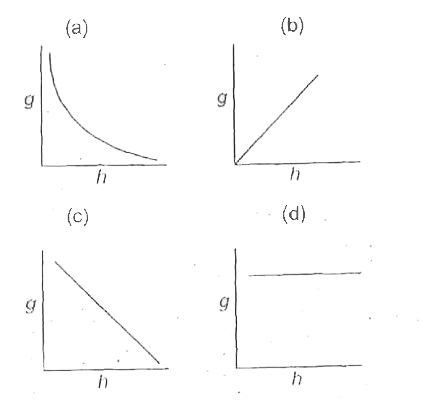The value of acceleration due to gravity (g) at height h above the surface of earth is given by
g′=gR2(R+h)2. If h<<R, then prove that g′=g(1−2hR).
To prove that the value of acceleration due to gravity g′ at a height h above the surface of the Earth is given by
g′=g(1−2hR)
given the formula
g′=gR2(R+h)2
where h≪R, we can follow these steps:
Step 1: Start with the given formula
We have:
g′=gR2(R+h)2
Step 2: Expand the denominator
We can expand the denominator (R+h)2 using the binomial expansion. Since h is much smaller than R, we can write:
(R+h)2=R2+2Rh+h2
However, since h≪R, we can ignore h2 in our approximation:
(R+h)2≈R2+2Rh
Step 3: Substitute the expanded denominator back into the formula
Now substituting this back into our expression for g′:
g′=gR2R2+2Rh
Step 4: Factor out R2 from the denominator
We can factor R2 out of the denominator:
g′=gR2R2(1+2hR)=g1+2hR
Step 5: Use the approximation for small x
For small x, we can use the approximation:
11+x≈1−x
Thus, applying this approximation where x=2hR:
g′≈g(1−2hR)
Conclusion
Therefore, we have shown that:
g′=g(1−2hR)
This completes the proof.
---
We have:
We can expand the denominator (R+h)2 using the binomial expansion. Since h is much smaller than R, we can write:
Now substituting this back into our expression for g′:
We can factor R2 out of the denominator:
For small x, we can use the approximation:
Therefore, we have shown that:
Topper's Solved these Questions
- BOOK - CENGAGE PHYSICS ENGLISHCHAPTER - BASIC MATHEMATICSEXERCISE - Solved Examples9videos
BASIC MATHEMATICS
- BOOK - CENGAGE PHYSICS ENGLISHCHAPTER - BASIC MATHEMATICSEXERCISE - Exercise 2.12videos
BASIC MATHEMATICS
- BOOK - CENGAGE PHYSICS ENGLISHCHAPTER - ARCHIVES 2 VOLUME 6EXERCISE - Integer4videos
ARCHIVES 2 VOLUME 6
- BOOK - CENGAGE PHYSICS ENGLISHCHAPTER - CALORIMETRYEXERCISE - Solved Example13videos
CALORIMETRY
Similar Questions
The ratio of acceleration due to gravity at a height 3 R above earth's surface to the acceleration due to gravity on the surface of earth is
(R = radius of earth)View SolutionThe acceleration due to gravity at height R above the surface of the earth is g4. The periodic time of simple pendulum in an artifical satellie at this height will be :-
View SolutionThe value of 'g' reduces to half of its value at surface of earth at a height 'h', then :-
View SolutionIf g is the acceleration due to gravity and R is the radius of earth, then the dimensional formula for g R is
View SolutionFind the acceleration due to gravity at a point 64km below the surface of the earth. R = 6400 k, g on the surface of the earth =9.8ms−2.
View SolutionThe value of gravitational acceleration 'g' at a height 'h' above the earth's surface is g4, then (R = __________ ) (where R = radius of the earth)
View SolutionWhich of the following graphs shows the variation of acceleration due to gravity g with depth h from the surface of the earth ?
 View Solution
View SolutionIf ge,gh and gd be the acceleration due to gravity at earth’s surface, a height h and at depth d respectively . Then:
View SolutionAssertion : If rotation of earth about its own axis is suddenly stops then acceleration due to gravity will increase at all places on the earth.
Reason : At height h from the surface of earth acceleration due to gravity is gh=g(1−2hRe).View SolutionThe value of g at a certain height h above the free surface of the earth is x/4 where x is the value of g at the surface of the earth. The height h is
View Solution
